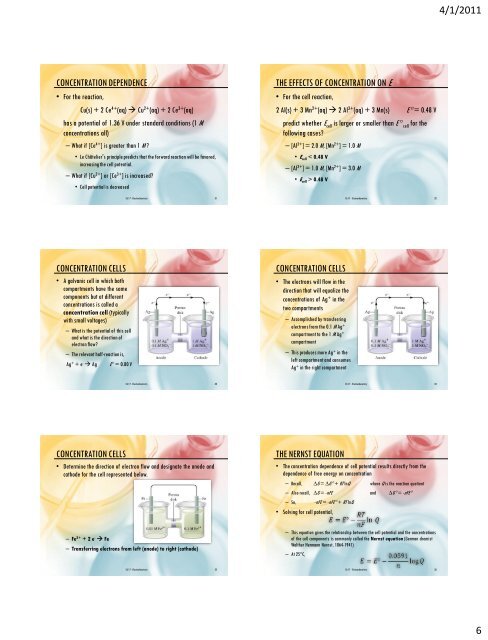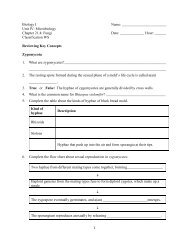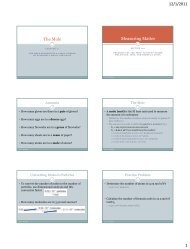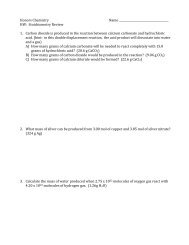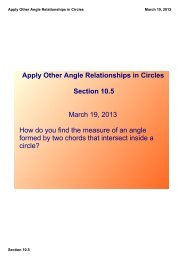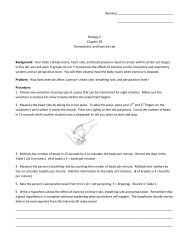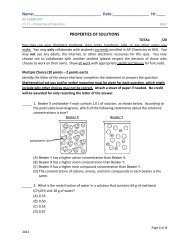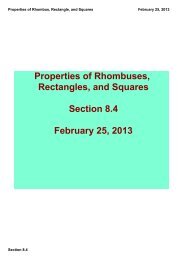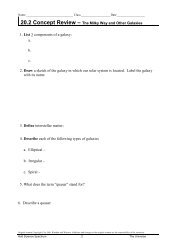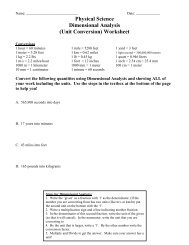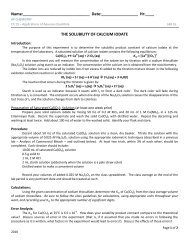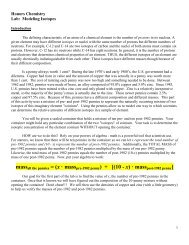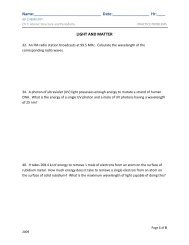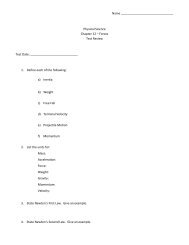Electrochemistry (Ch 17) - AP Chemistry
Electrochemistry (Ch 17) - AP Chemistry
Electrochemistry (Ch 17) - AP Chemistry
You also want an ePaper? Increase the reach of your titles
YUMPU automatically turns print PDFs into web optimized ePapers that Google loves.
4/1/2011<br />
CONCENTRATION DEPENDENCE<br />
• For the reaction,<br />
Cu(s) + 2 Ce 4+ (aq) Cu 2+ (aq) + 2 Ce 3+ (aq)<br />
has a potential of 1.36 V under standard conditions (1 M<br />
concentrations all)<br />
– What if [Ce 4+ ] is greater than 1 M <br />
• Le <strong>Ch</strong>âtelier's principle predicts that the forward reaction will be favored,<br />
increasing the cell potential.<br />
– What if [Cu 2+ ] or [Ce 3+ ] is increased<br />
• Cell potential is decreased<br />
THE EFFECTS OF CONCENTRATION ON E<br />
• For the cell reaction,<br />
2 Al(s) + 3 Mn 2+ (aq) 2 Al 3+ (aq) + 3 Mn(s) E = 0.48 V<br />
predict whether E cell is larger or smaller than E cell for the<br />
following cases<br />
– [Al 3+ ] = 2.0 M, [Mn 2+ ] = 1.0 M<br />
• E cell < 0.48 V<br />
– [Al 3+ ] = 1.0 M, [Mn 2+ ] = 3.0 M<br />
• E cell > 0.48 V<br />
<strong>Ch</strong> <strong>17</strong> - <strong>Electrochemistry</strong> 31<br />
<strong>Ch</strong> <strong>17</strong> - <strong>Electrochemistry</strong> 32<br />
CONCENTRATION CELLS<br />
• A galvanic cell in which both<br />
compartments have the same<br />
components but at different<br />
concentrations is called a<br />
concentration cell (typically<br />
with small voltages)<br />
– What is the potential of this cell<br />
and what is the direction of<br />
electron flow<br />
– The relevant half-reaction is,<br />
Ag + + e - Ag<br />
E = 0.80 V<br />
CONCENTRATION CELLS<br />
• The electrons will flow in the<br />
direction that will equalize the<br />
concentrations of Ag + in the<br />
two compartments<br />
– Accomplished by transferring<br />
electrons from the 0.1 M Ag +<br />
compartment to the 1 M Ag +<br />
compartment<br />
– This produces more Ag + in the<br />
left compartment and consumes<br />
Ag + in the right compartment<br />
<strong>Ch</strong> <strong>17</strong> - <strong>Electrochemistry</strong> 33<br />
<strong>Ch</strong> <strong>17</strong> - <strong>Electrochemistry</strong> 34<br />
CONCENTRATION CELLS<br />
• Determine the direction of electron flow and designate the anode and<br />
cathode for the cell represented below.<br />
THE NERNST EQUATION<br />
• The concentration dependence of cell potential results directly from the<br />
dependence of free energy on concentration<br />
– Recall, ∆G = ∆G + RT lnQ where Q is the reaction quotient<br />
– Also recall, ∆G = -nFE and ∆G = -nFE<br />
– So, -nFE = -nFE + RT lnQ<br />
• Solving for cell potential,<br />
– Fe 2+ + 2 e - Fe<br />
– Transferring electrons from left (anode) to right (cathode)<br />
– This equation gives the relationship between the cell potential and the concentrations<br />
of the cell components is commonly called the Nernst equation (German chemist<br />
Walther Hermann Nernst, 1864-1941)<br />
– At 25C,<br />
<strong>Ch</strong> <strong>17</strong> - <strong>Electrochemistry</strong> 35<br />
<strong>Ch</strong> <strong>17</strong> - <strong>Electrochemistry</strong> 36<br />
6


